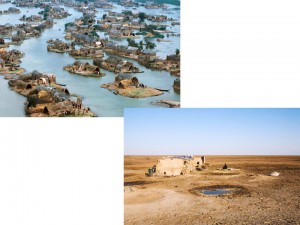- Maize boffins move on to RNA. Hard row to hoe.
- The coolness of hybrids. No, not the cars. Includes crop wild relatives.
- Bioversity makes the case that cacao is charismatic. Hard row to hoe.
- IITA tries to crowdsource banana production data. Hard row to hoe. BTW, why not include variety information? Well, maybe they will.
- Jatropha rebooted?
- The history of barley water. Surprisingly weird.
- Cory Bradshaw’s presentation on the global erosion of ecosystem services. A quick look reveals little on that often overlooked service: the provision of diversity for agriculture.
- The importance of coca in Andean culture.
- Chinese medicinal herbs doing just fine in North Carolina.
- FAO hunger report parsed by The Guardian.
Nibbles: Kew, Diversity, Allanblackia and Acacia, Pulses, GIS, Poverty, Early morning flowering, Agrobiodiversity and climate change, Breeding, Genebanks, Perenniality, Blogs, AGRA, Potato diversity, Witchweed, Mexican potatoes, Salvia, Old Sicilian chestnut, Tropical maize
- Guardian has whole piece on the importance on Kew’s collections without once mentioning Millennium Seed Bank. Anyway, the Paris herbarium is not so bad either, though they are no match for the Kew press machine.
- Hybridization is good for plant diversity. Well, yeah. What am I missing here? Oh and here’s more about things that maintain variation, and more still. You see what I did there?
- Allanblackia is the next big thing in agroforestry. Which probably means its name will soon be changed.
- Conclave meets to discuss
election of next Popepulse productivity. - Videos from Africa GIS week.
- Meeting to review 10 years of research on chronic poverty. Must have been deeply depressing.
- Helping rice to keep its cool. A crop wild relatives story.
- “The Ministry of Science and Technology should emphasize the need to undertake research programmes on unexplored and underutilized crops as these could constitute the genetic base for genes for improved nutritional quality of foods.” In India, that is.
- “We need to mine that diversity to provide genetic material in an adapted background more readily to be used by plant breeders.” From CIMMYT. How many times have I heard that? Here’s my problem: who will do it?
- That IRIN feature from a few days ago recycled with a new pic. Which is of a genebank not included in the list in the text. The person shown is my friend Dr Jean Hanson, recently retired head of the ILRI genebank.
- DIY perennial cereals.
- “Biodiversity scientists and agricultural scientists have tended to approach their interests in very different ways. I think there’s a lot we can learn from each other.” Wait, what?
- Another best biodiversity blogs list. Ahem.
- A “very clear action plan” for a ‘Green Revolution’ in Africa emerges from AGRA meeting. You will however look in vain for the details on the scidev.net piece.
- The last Inka treasure. Yep, the potato.
- Boffins find anti-Striga gene. No, not really, settle down.
- Rachel Laudan is really rude about Mexican potatoes.
- Cur moriatur homo cui salvia crescit in horto? Good question.
- Finding the 100-Horse Chestnut.
- Getting to grips with photoperiod sensitivity in maize.
Nibbles: Cattle nutrition, Maize, Freshwater biota, Modeling maize, Rice, Book, Veg, Urban ag
- Climate change ain’t going to be good for cattle.
- But will be fabulous for breeders of drought-resistant maize.
- A fifth of Africa’s freshwater plants and animals threatened. How many of these are important to local people’s nutrition and health? A lot, I bet.
- Just a couple guys, modeling the spread of maize genetic diversity in the Americas.
- Uganda turns to wild relatives for new rice varieties.
- Toward Sustainable Agricultural Systems in the 21st Century recognizes importance of agrobiodiversity. Good to know.
- New Agriculturalist revisits veg-garden-in-a-sack.
- FAO policy brief on urban agriculture.
Bringing back the Iraqi marshes
We blogged over a year ago about the re-flooding of the Iraqi marshes, but fairly briefly, and it’s great to see a long piece about this restoration process in Der Spiegel today. The slideshow which accompanies the article provides the best visual summary I’ve seen of what happened to the marshes — and their inhabitants, with their crops and livestock. I’ve put the “before” and “after” shots side-by-side below:

Apart from its inherent interest, the Der Spiegel article also gives me the excuse to mention that a detailed map of the world’s river systems has just been made available, by Bernhard Lehner at McGill University in Montréal, Canada. Is anyone keeping track of the proliferation of such global geographic dataset? Google? ESRI? The CGIAR’s Spatial Information Conundrum? Anyone?
Nibbles: CGIAR “change”, Cuba, Data, Pavlovsk, Homegardens, Soil bacteria, Thai rice
- GFAR publishes list of Megaprogramme (or whatever they are called) consultations.
- Cuba’s Miscellaneous Crops Under-delegate Rolando Macias Cardenas reports on tomato paste. In other news, Cuba has a Miscellaneous Crops Under-delegate. No, wait, that’s not really news.
- While Sachs et al. moan about better agricultural data, CIAT go out and get it.
- The Pavlovsk TweetMedvedev campaign rolls on.
- “…maximum diversity can be conserved at an intermediate level of income” in Javanese bamboo-tree homegardens.
- Right, so trees “farm” bacteria. What some people will write in a press release.
- Thailand’s rice farmers trying to cope with climate change. Like they have a choice.